Table of Contents
Crude Minnesota taconite was charged in the Bureau of Mines experimental blast furnace so that smelting characteristics of such highly siliceous raw materials could be studied and smelting costs compared with those of a standard Mesabi ore. The Bureau recognized that the highly siliceous nature of the crude ore and its relatively low metallic content would be serious economic deterrents to commercial use of the raw taconite, but compensating factors would be low capital investment in production facilities, large tonnage available on short notice, high recoveries of iron, and low delivered cost.
Crude taconite smelted readily in the experimental blast furnace. Coke consumption per ton of metallic product was very high, compared with the average established requirements for smelting normal grades of metalliferous raw materials. Slag rates were also inordinately high. Metal quality was erratic as to silicon, and sulfur contents were objectionably high.
Under the conditions of the tests, a pig iron production cost of $60 per net ton is indicated, compared with approximately $45 if high-grade calcined taconite pellets were used. The economics of smelting crude taconite would be more favorable for producing standard-grade or high-silicon iron if a procedure could be developed to permit operation with lower slag volumes. Additional research is needed in these areas.
Taconite is a designation given to the unaltered iron formations of the Lake Superior district. It consists of ferruginous chert or slate in which iron oxide is very finely disseminated. In some areas the iron occurs largely as magnetite. Current production is obtained from concentration of such ores by fine grinding and magnetic separation. Other measures will be required for effective utilization of the hematitic taconites, which constitute most of the potential reserve. The iron content of taconite may be as high as 35 percent in some localities but the general average is less than 27 percent.
Exploitation of taconite requires the rejection of siliceous gangue. Concentration requires crushing and very fine grinding for liberation of iron minerals from the gangue. An agglomerating process is then necessary to convert the concentrates into a physical form suitable for blast-furnace smelting.
These disadvantages of mechanical separation suggest a reexamination of pyrometallurgical methods for eliminating the siliceous gangue as a slag. Wuerker has described the application of the Krupp-Renn process to siliceous iron ores by reduction in a rotary furnace. Although this process will produce metal containing 95 to 98 percent Fe, it is subject to serious practical disadvantages such as the low capacity of rotary furnaces and the short life of the refractory lining. This raises the question as to what extent the blast furnace can be adapted to smelting siliceous iron ores.
The experimental work described in this report was a preliminary step in a feasibility study to determine the extent to which a blast furnace can be used for beneficiation of siliceous iron ores.
A further consideration was the possibility that taconite might replace other lean ores or gravel where a siliceous burden addition is needed in the blast furnace to increase the volume of slag for sulfur control or to produce silvery (high-silicon) iron.
The experimental furnace and auxiliary equipment used in this investigation have been described.
Raw Materials Used
The compositions of the raw materials used in the smelting experiments are shown in table 1.
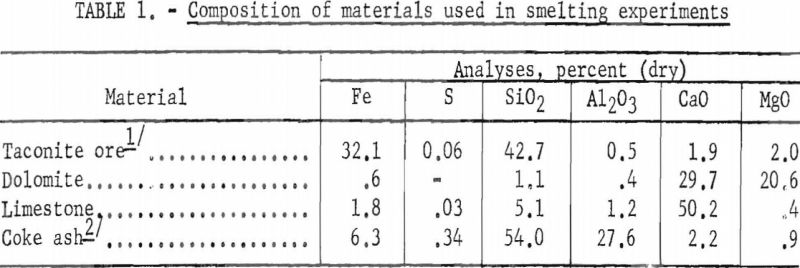
The various raw materials used in the burden were procured in the following size ranges: Coke, minus-1-¾-inches, plus-1-inch; limestone, minus-2-½-inches, plus-15/16-inch; dolomite, minus-1-7/8-inches, plus-¾-inch; raw taconite ore, minus-2-inches. The coke was screened on a ½-inch screen before charging to remove any fines caused by handling, and the taconite ore was screened on a 10-mesh (later 4-mesh) screen to remove the fines portion of the crushed ore.
Blowing-in Furnace
The experimental furnace was blown-in on a burden consisting of coke, scrap iron, and blast-furnace slag. The transition from scrap iron and blast-furnace slag to a smelting burden was accomplished in stages at a moderate degree of change. The hearth and bosh sections were filled with 4,600 pounds of coke only. The filling schedule above this cokebed is shown in table 2. Thereafter the charging proceeded on a basis of 2-skip rounds consisting of
200 pounds of coke, 280 pounds of minus 4-inches, plus-10-mesh open hearth slag, and 19 pounds each of limestone and dolomite.
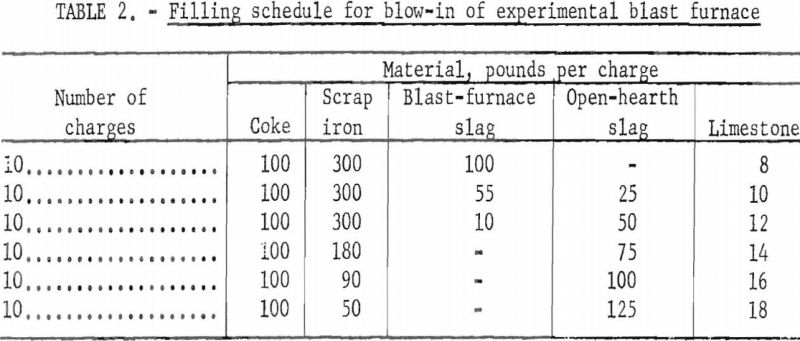
Smelting Operation Using Plus 10-Mesh Ore
The furnace was operated on a burden ratio (open-hearth slag to coke) of 1.40 for one full day when stable operations were reached. Then the change-over to taconite was made by progressively removing open-hearth slag from the charge and adding plus-10-mesh taconite in equivalent weights to maintain the same burden ratio.
Because of the very high siliceous gangue content of the ore (43 percent), each increase in burden ratio on the basis of ore-to-coke charge imposed an abnormally high total-burden load because of the basic fluxing agents that were added. Each pound of taconite contained 0.39 pound of oxides (acids minus bases) which required an addition of 0.80 pound of limestone or 0.72 pound of dolomite to attain a 0.90 slag basicity. Thus each pound increase in ore burden actually resulted in a 1.72- to 1.80-pound overall load on the furnace. Consequent increases in thermal requirements for calcination of the stone and for heating the increased volume of slag to its final temperature resulted. In order to limit the load on the furnace, the basic oxides were proportioned so that the resulting slags were slightly acidic (0.85 to 0.95 CaO + MgO/SiO2 + Al2O3 ratio) instead of the usual 1.05 to 1.15 basicity maintained for basic pig iron production.
Economic considerations necessitated attainment of maximum metal production at a reasonable rate of coke consumption. The furnace was therefore burdened progressively with ore, and the attendant basic flux requirement, to the extreme loading that could be accommodated and meanwhile maintain even smelting conditions. Actually, in the attempt to arrive at the ultimate loading that was operationally satisfactory, an overload was reached that resulted in hanging of the stock column.
Tuyere pressure records provide initial indications of changing conditions in the stock column, including development of hanging which frequently results in inability to maintain the airblast flow rate. When such a state develops, the smelting activity in the bosh zone is retarded to the extent that drastic remedial measures must be applied to prevent cessation of operations.
The tuyere pressure was relatively stable for 5 days except for slight changes when the rate of blast was increased and when the top-gas washer system became constricted for 3 hours. On the sixth day of operation an indication of a change in condition of gas flow was indicated by a gradual increase in pressure. This occurred during a period when burden loading and hot-blast temperatures also were being increased. Then at midday when the ore-to-coke ratio had reached 1.80, a sudden increase in the tuyere pressure indicated severe restriction to gas flow in the column. The restriction was of short duration, and the pressure dropped to a lower level than had existed before the sudden increase. Thereafter, the record became increasingly erratic. Six hours later gas flow became so seriously hampered that the scheduled 1,000 c.f.m. of air could not be maintained, and the operation was discontinued temporarily.
There is, of course, a limit to burden ratio for a particular grade or type of raw material at which a furnace may be operated satisfactorily. The limit for plus-10-mesh crude taconite is at 1.75 burden ratio; at loadings of 1.80 and higher, the operation was erratic and difficult to maintain.
Smelting Operations Using Plus 4-Mesh Ore
After the furnace was cleared of the stock contained at the time of this forced shutdown, it was blown-in again by the procedure described earlier,. The raw-taconite burden was increased in increments at regular intervals from 1.00 to 1.75 burden ratio for 26 hours. The 1.75 ore-coke ratio was expected to be a workable loading based on previous experience. However, an occasional surge above normal on the tuyere pressure record and the need for an unusually high hot-blast temperature indicated that an irregular condition was developing again in the stock column. It was hoped that the condition would correct itself with continued operation. However, when full blast was applied after checking the wind momentarily for taphole closure at cast, the tuyere pressure increased to the pressure limit of the blower and loss of blast volume through the furnace resulted. Alternately increasing and releasing blast pressure (checking) provided occasional relief and permitted the use of a normal rate of wind. The ore-coke ratio was decreased to 1.65 as a possible means of alleviating the hanging of the column and restricting of gas flow. However, no advantage could be gained from this change until the lighter burden descended to the smelting zone.
After 24 hours of low blast rate and frequent checking, the stock column loosened to the extent that the scheduled airblast of 1,000 c.f.m. could be applied and smooth operations appeared possible at a blast temperature of 1,700° F. and ore-coke ratio of 1.65.
With furnace performance smoothed out, a higher wind rate of 1,100 c.f.m. with an ore-coke ratio of 1.70 was attempted. Two periods of restricted gas- flow were encountered within the next 5 hours of operation, but the condition was corrected by frequent checking and periodic decreasing of the hot blast temperature to 1,500° F. Smelting operations at a wind rate of 1,100 c.f.m. were maintained for 3 days, except for a necessary reduction over a 4-hour period for mechanical repairs.
After 32 hours of the 3-day operation, the ore-coke ratio head was increased to 1.80 and the hot-blast temperature was raised in increments of 25° F. as smelting conditions indicated the need for additional heat to maintain silicon in the 1-percent range in the metal. Hanging and resistance to gas flow through the stock column occurred again at the 1.80 ore-coke ratio and with hot-blast temperatures in the range of 1,700 to 1,750° F. The hanging condition was alleviated by lowering the hot-blast temperature to the 1,600°-1,650° F. range. Although the furnace operated at normal tuyere pressure and stock movement appeared satisfactory, the smelting activity was retarded at the lower hot-blast temperature level as evidenced by progressively lower silicon and higher sulfur contents of the metal produced.
In an effort to improve analysis of the metal, the hot-blast temperature was increased to 2,000° F. However, irregular operation occurred at this temperature, indicating that a 1.80 ore-coke ratio and the attendant load of fluxing agents was too high for satisfactory smelting operations. Smelting during the succeeding hours proceeded at normal tuyere-pressure readings but under progressively colder operating conditions, as evidenced by the low-silicon, high-sulfur contents of the metal product despite progressive increment increases of hot-blast temperature to a maximum of 2,050° F. Again, irregular operation developed at this stage of hot-blast application and on the 1.80 ore burden. Hanging and restriction to gas flow were frequent and severe enough to decrease the rate of production, increase the consumption of coke, and generally impair the effectiveness of operations. These, conditions developed just 18 hours before the scheduled shutdown, and corrective measures could not be taken. Evidence was clear, however, that the limiting burden ratio was between 1.75 and 1.80.
Discussion of Results
Various operating items and experimental results of the taconite ore smelting are shown on a daily basis in table 3. The first day of a smelting period was not included in the tabulation because some 24 hours of operation are essential to establish stable smelting conditions in the experimental furnace. It is to be noted also that the data recorded for the initial several days of a period represent the transition from blow-in burden of open-hearth slag to the crude taconite ore operations.
The progressive increase of taconite ore charged is shown in the tabulation for the two operating periods. The attendant limestone and dolomite additions for attaining a certain degree of basicity in the slag are also shown. Comparative data are readily obtainable on consumption of coke, production of metal and slag, analysis of metal and slag, top-gas temperatures and composition, basicity of slag, rates of air blast, and temperatures.
The data indicate the approximate loads of taconite ore and fluxing agent at which most effective smelting occurred in the two operating periods. The effective burden loads occurred on test days 5 and 12. Any change in the burden ratio from this effective range resulted in higher consumption of coke; overloads were evidenced by irregular movement of stock, hanging, and decreased permeability of the stock materials to gas passage. Loss of stock permeability and hanging occurred on the last day of each operating period.
The smelting of taconite, a highly siliceous raw material, presented an opportunity to note the effects of high-silicon-content metals and high-iron-content slags. Figures 1 and 2 show the trend in silicon and sulfur contents of the metal, respectively, as related to the iron content of the slag. The plots exhibit the scatter pattern that often is obtained when several variables influence the items under consideration. In this instance, the smelting zone temperatures, different burden loadings, and variable basicity of the furnace slags affect the plotted items to some degree of balance or imbalance. Therefore, the general trend of the plot is of interest rather than attaching significance to individual points.
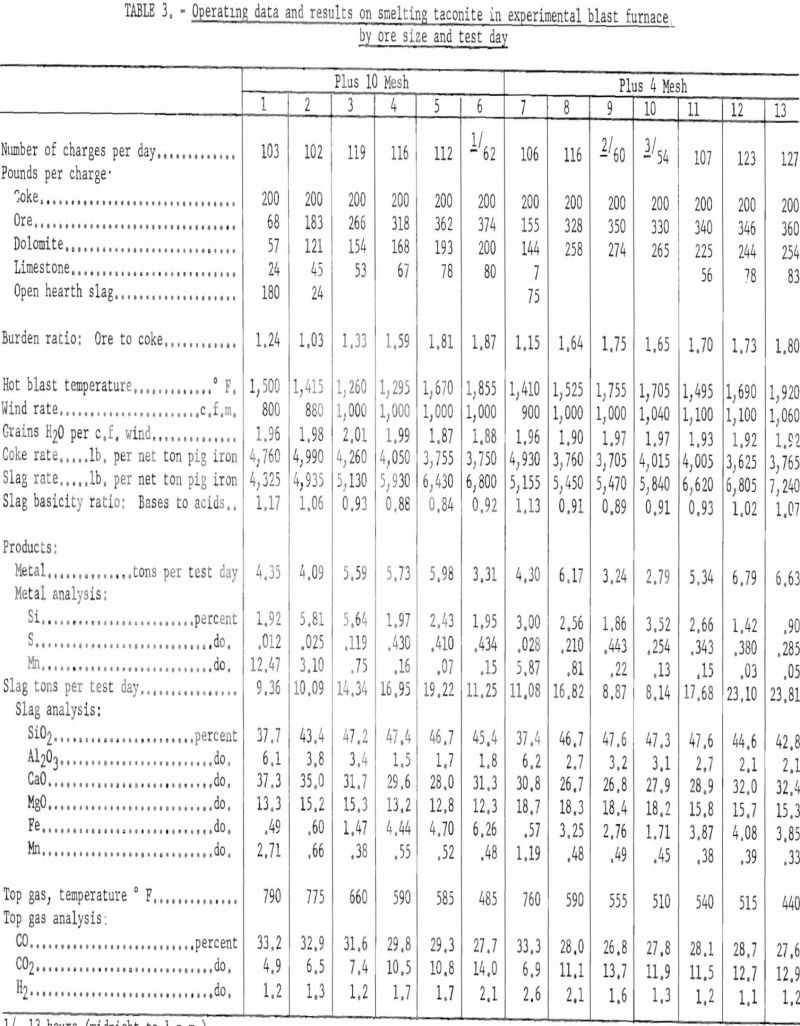
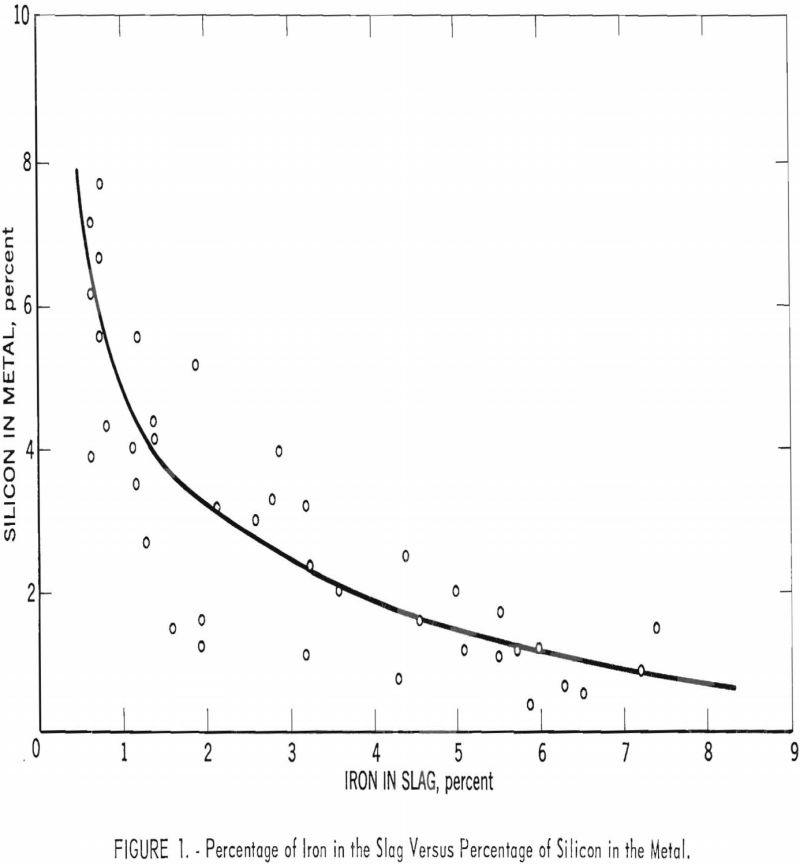

The data in table 4 are presented to facilitate comparisons of the two sizes of ore at approximately equal burden ratios and wind rates. Average data for 28- to 37-hour operating periods have been tabulated in order of increasing burden ratios. There are, in addition, some deliberate variations of slag basicity superimposed upon the other changes, which must be considered in the interpretation of results. It would have been more desirable to establish the effects of these variables independently, but the cost of the additional work that would have been necessary did not seem justified.

Scheduling the blast furnace runs called for burdening the furnace increasingly until the silicon reached the desired level of 0.75 to 1.25 percent, and at the same time holding the slag as acid as possible and the hearth temperature on the hot side. Accordingly, the first run using plus-10-mesh ore showed a minimum coke rate of 3,710 pounds per ton of pig iron at an ore-coke ratio of 1.81 and the metal silicon at 2.60 percent. The plus 4-mesh size taconite run showed a minimum coke rate of 3,765 pounds at a burden ratio of 1.80 and silicon in the metal at 1.10 percent. However, the ore-coke ratio was above the level that would permit smooth furnace operation. Increased burdening to the 1.80 rate and a basic slag (1.04 ratio, bases to acids) brought the silicon in the metal within the 0.75 to 1.25 range. However, the volume of slag was very high, and the sulfur content (0.285 percent) was inordinately high for normal basic-quality iron. A comparison of the data for this operation with those for a standard Mesabi ore is shown in table 5.
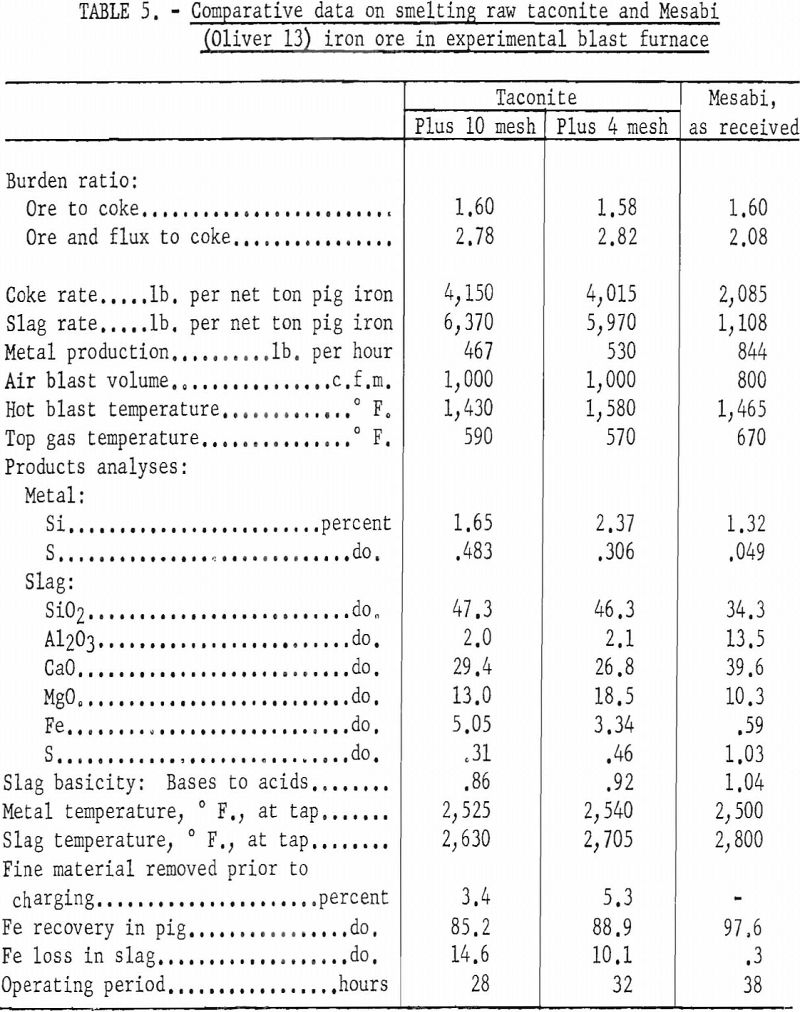
The Mesabi burden contained 56.7 percent iron, 10 percent silica, 2.9 percent alumina, and 2.6 percent total lime and magnesia. The proportion of ore to coke in the burden was almost identical for the tabulated periods. However, the load of ore and flux was 32 to 36 percent higher for the taconite operation because of the greater quantities of limestone and dolomite needed.
Comparatively, coke consumption per ton of pig metal for the taconite operation was about twice the rate of that for Mesabi ore. The slag-production rate of the taconite smelting was 5.5 to 5.75 times greater than the 1,100 pounds of slag resulting from the Mesabi ore. Iron losses in the slag were far greater than for the Mesabi ore; iron recovery in the pig metal was only 85 to 89 percent of the iron input to the furnace.
Smelting with Basic Slag
A comparison of the data on the two taconite sizes indicates that the Significant difference was in the slag volumes per ton of metal produced at the 1.80 burden ratio. The plus-4-mesh taconite charge was burdened with basic fluxing agents to attain a basic slag. The resulting slag volume on plus-4-mesh 1.80 burden and 1.04 slag basicity was 850 pounds higher per ton than the operations on plus-10-mesh taconite at 1.81 burden ratio with an acidic slag, 0.88, bases-acids ratio. The higher thermal requirements for calcining and melting the increased fluxing agent load required more fuel; therefore, the coke rate per ton of metal produced was 55 pounds higher than the rate attained at lower burden loads of ore and basic stone. The increased thermal demands for the operations to basic slag conditions could not be supplied by increased hot-blast temperature because a sticking condition developed in the stock column when a hot-blast temperature of 1,900° F. or higher was applied.
Iron reduction was not improved by operating under basic slag conditions at the 1.80 burden ratio loading. Also the high coke consumption required under these conditions is a definite indication that burdening into the basic range is not advantageous, particularly at high burden loading.
Heat Balance for Taconite Ore Smelting
The high thermal requirements per short ton of metal product from crude taconite are shown in table 6. A heat balance for a period of Mesabi burden is included for comparison with the taconite operations. The 21 to 22 million B.t.u. needed for the siliceous taconite are more than twice as much as the 9.5 million B.t.u. required for smelting a Mesabi ore and sinter. The cooling and radiation losses for the experimental furnace are much higher (about 25 percent of the total compared with some 10 percent of large industrial furnaces). The principal heat consumption, however, lies in the requirements for dissociation of limestone and dolomite and the sensible heat of the large slag volume per ton of metal produced and the wet gas removed from the furnace top. These items account for nearly 60 percent of the total heat consumption.
Production Costs
The base units for estimating comparative costs of smelting raw taconite ore and taconite concentrate pellets to pig iron are shown in table 1.
The comparative costs of shipping, processing, and smelting raw taconite and concentrate pellets are itemized in table 8.
The comparative production cost estimates for smelting crude taconite to pig iron in the Pittsburgh (Pa.) district versus pelletized concentrates show that smelting ore is more expensive. A credit of the market value for the 2.5 to 3.0 tons of blast furnace slag produced on smelting the crude ore would lower the net cost of the iron product somewhat. Then an additional credit would be realized if the ore were smelted at the Lower Lake ports, the saving being the difference between $6.97 and $3.42 shipment costs for 3.10 tons of taconite ore and 1.52 tons concentrate pellets, respectively.
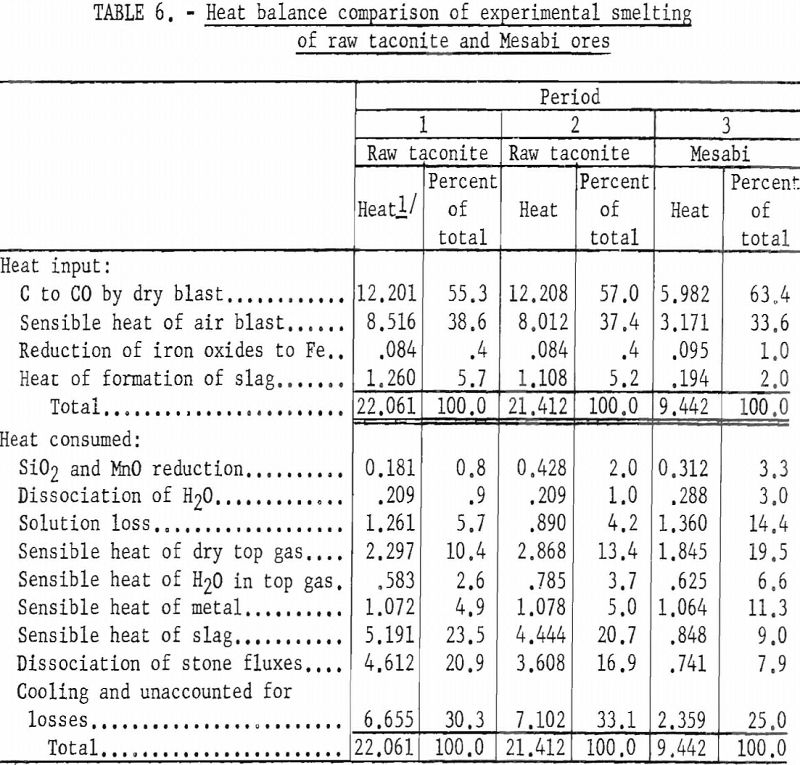


Conclusions
- Crude taconite will smelt easily to pig iron, but based upon these investigations the production rate would be only about one-half that of standard Mesabi ore. Coke consumption was correspondingly high, totaling 3,615 pounds and more at 1,000 std. c.f.m. wind rate.
- Burdening the furnace with basic oxide materials sufficient to produce normal basic iron of 0.80 to 1.20 percent Si and 0.05 percent maximum S is impractical because of the enormous load of limestone and dolomite needed to produce a sufficiently basic slag to control silicon and sulfur within the specified limits.
- Adjustment of operations to produce silvery iron containing up to 10 percent Si presents a possible method for direct smelting of crude taconites in the blast furnace. The lower slag volumes and reduced requirement for basic flux could result in substantial savings in total thermal requirements in the smelting operation.
- Future experiments with highly siliceous ores should be designed to operate on even more acid slags and to increase the metallic burden to utilize thermal input for reduction rather than for melting more slag and supplying the enormous energy requirements for the dissociation of carbonate flux.
